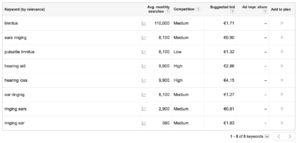Below is a recent study that will published this month on clinically significant tinnitus. The study offers no new information; we all know that tinnitus risk increases with age. But, still, the rising burden of tinnitus on the health care system should increase demand for research funds.
Ear Hear. 2014 Dec 2. [Epub ahead of print]
Incidence Rates of Clinically Significant Tinnitus: 10-Year Trend From a Cohort Study in England.
Martinez C1, Wallenhorst C, McFerran D, Hall DA.
Author information
Abstract
OBJECTIVE::
To investigate the incidence of tinnitus that burdens the health service in England.
DESIGN::
This was an observational study of 4.7 million residents of England under 85 years of age who were at risk for developing clinically significant tinnitus (sigT). SigT was defined by a discharge from hospital with a primary diagnosis of tinnitus, or a primary care recording of tinnitus with subsequent related medical follow-up within 28 days. The database used was the Clinical Practice Research Datalink and individual records were linked to additional data from the Hospital Episode Statistics. The observational period was from January 1, 2002 to December 31, 2011. Age-, gender-, and calendar year-specific incidence rates for and cumulative incidences of sigT were estimated and a projection of new cases of sigT between 2012 and 2021 was performed.
RESULTS::
There were 14,303 incident cases of sigT identified among 26.5 million person-years of observation. The incidence rate was 5.4 new cases of sigT per 10,000 person-years (95% confidence interval: 5.3 to 5.5). The incidence rate did not depend on gender but increased with age, peaking at 11.4 per 10,000 in the age group 60 to 69 years. The annual incidence rate of sigT increased from 4.5 per 10,000 person-years in 2002 to 6.6 per 10,000 person-years in 2011. The 10-year cumulative incidence of sigT was 58.4 cases (95% confidence interval: 57.4 to 59.4) per 10,000 residents. Nearly 324,000 new cases of sigT are expected to occur in England between 2012 and 2021.
CONCLUSIONS::
Tinnitus presents a burden to the health care system that has been rising in recent years. Population-based studies provide crucial underpinning evidence; highlighting the need for further research to address issues around effective diagnosis and clinical management of this heterogeneous condition.This is an open access article distributed under the Creative Commons Attribution License, which permits unrestricted use, distribution, and reproduction in any medium, provided the original work is properly cited.
Ear Hear. 2014 Dec 2. [Epub ahead of print]
Incidence Rates of Clinically Significant Tinnitus: 10-Year Trend From a Cohort Study in England.
Martinez C1, Wallenhorst C, McFerran D, Hall DA.
Author information
Abstract
OBJECTIVE::
To investigate the incidence of tinnitus that burdens the health service in England.
DESIGN::
This was an observational study of 4.7 million residents of England under 85 years of age who were at risk for developing clinically significant tinnitus (sigT). SigT was defined by a discharge from hospital with a primary diagnosis of tinnitus, or a primary care recording of tinnitus with subsequent related medical follow-up within 28 days. The database used was the Clinical Practice Research Datalink and individual records were linked to additional data from the Hospital Episode Statistics. The observational period was from January 1, 2002 to December 31, 2011. Age-, gender-, and calendar year-specific incidence rates for and cumulative incidences of sigT were estimated and a projection of new cases of sigT between 2012 and 2021 was performed.
RESULTS::
There were 14,303 incident cases of sigT identified among 26.5 million person-years of observation. The incidence rate was 5.4 new cases of sigT per 10,000 person-years (95% confidence interval: 5.3 to 5.5). The incidence rate did not depend on gender but increased with age, peaking at 11.4 per 10,000 in the age group 60 to 69 years. The annual incidence rate of sigT increased from 4.5 per 10,000 person-years in 2002 to 6.6 per 10,000 person-years in 2011. The 10-year cumulative incidence of sigT was 58.4 cases (95% confidence interval: 57.4 to 59.4) per 10,000 residents. Nearly 324,000 new cases of sigT are expected to occur in England between 2012 and 2021.
CONCLUSIONS::
Tinnitus presents a burden to the health care system that has been rising in recent years. Population-based studies provide crucial underpinning evidence; highlighting the need for further research to address issues around effective diagnosis and clinical management of this heterogeneous condition.This is an open access article distributed under the Creative Commons Attribution License, which permits unrestricted use, distribution, and reproduction in any medium, provided the original work is properly cited.

 Member
Member Founder
Founder

